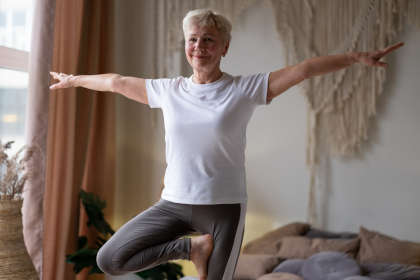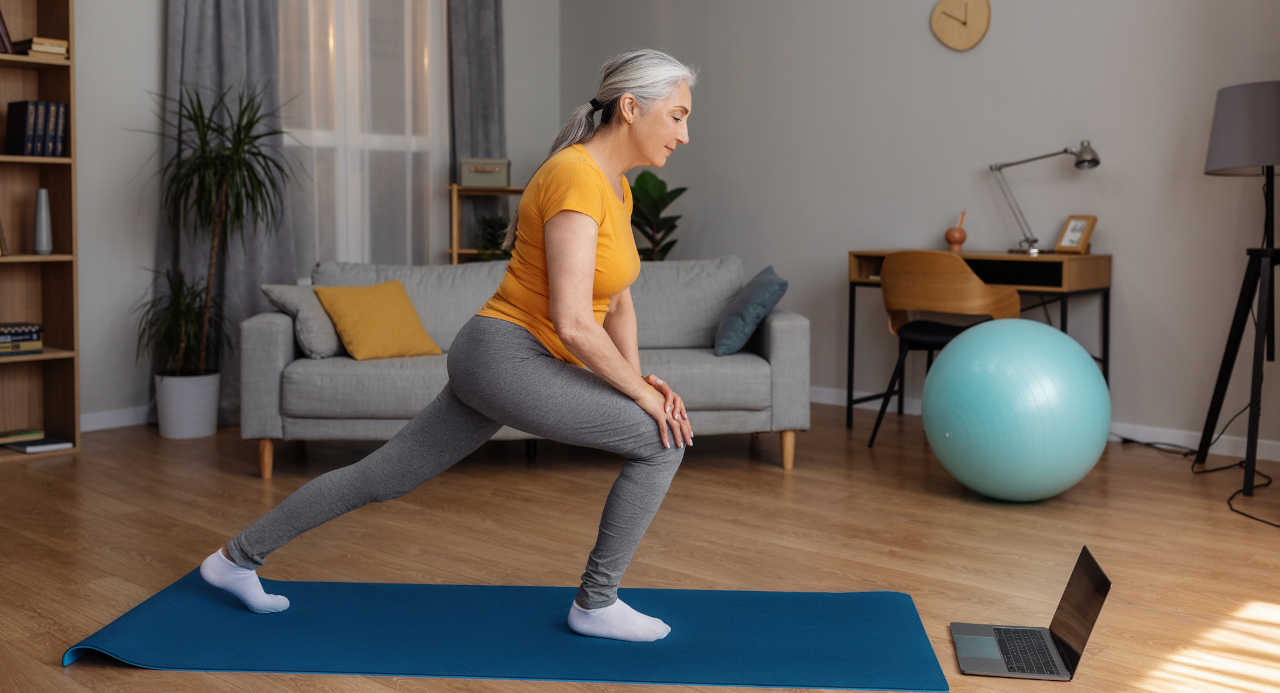Yoga is an excellent exercise option for seniors and has many positive mental and physical benefits. It enhances physical, mental, and spiritual well-being but has a low impact on muscles and joints. In terms of physical benefits, yoga can improve strength, flexibility, balance, and stability. In addition, yoga offers a variety of cognitive benefits, like managing stress and enhancing sleep.
Get Your Pills Pre-sorted and Delivered at No Extra Cost
In this article, we will discuss how people of any age can get started with yoga. We will also share some of the best, most effective, and simplest yoga exercises for seniors.
What Are the Benefits of Yoga for Seniors?
Yoga offers multiple benefits for seniors, including:
Strengthening Bones and Joints
Osteoporosis (the loss of bone mass, which weakens bone), and osteoarthritis (the degeneration of bone joints) are common problems we face as we age. However, engaging in gentle yoga practices that involve moving your joints and activating your muscles regularly can help reduce joint pain, stiffness, and tenderness. It also reduces the risk of bone injury as regular use of muscles can reduce the loss of bone density.
Managing Stress
Yoga exercises enhance relaxation through mindful breathing and meditation, which helps ease stress and anxiety naturally. In addition, physical movement and muscle activity can result in the release of endorphins, which can also improve mental health.
Improving Balance, Stamina, and Strength
Yoga involves exercises that improve core strength and balance by practicing holding poses or standing on one leg. This helps improve stability and reduces the risk of falls in the elderly. There are also many seated and reclined poses that can improve core strength and balance, and thus there are many options for practicing yoga, even for those that may have mobility issues or have difficulty standing for prolonged periods.
Enhancing Breathing
Gradual, deep, and controlled breathing in yoga improves lung capacity and enhances overall respiratory health. For example, “Ujjayi breathing,” one of the most common forms of breath control used in yoga — where breathing is performed through the nose with intentional tightening of the throat — has numerous benefits, including improved concentration and emotional health due to mindfulness of the breath.
Improving Sleep
Regular yoga helps to improve the overall quality and duration of sleep, alleviate sleep disturbances, and relieve insomnia in seniors. Regular exercise can assist in the production of melatonin in the body, which is the body’s natural sleep hormone. In addition, breathwork and physical activity can alleviate stress and relax both the body and mind, improving both the ability to fall asleep and overall sleep quality.
No More Pill Sorting! Our Pharmacy Pre-sorts and Packages Your Pills
How Seniors Can Get Started With Yoga
If you need help getting started with yoga, try the following steps:
Consult Your Healthcare Professional Before Starting
Before selecting or starting any type of yoga or new exercise, it is best to consult your healthcare professional. They are more aware of your overall health condition and can provide better guidance on whether yoga is appropriate for you based on your health.
Practice With an Instructor
The second step after consulting your healthcare professional is to start with a qualified and experienced instructor, especially if you are a beginner.
A certified yoga instructor will guide you step-by-step on how to perform yoga and monitor you to help prevent injuries. Starting with an instructor helps ensure that you are performing all the steps of the yoga poses correctly and safely. This is especially important for seniors, where the protection of muscles, bones, and joints is a priority for any physical exercise.
Start Slowly
For beginners, it is crucial to start slowly and not to push your body beyond its limits. Initially, start with beginner-level yoga that feels comfortable and safe. It is important to recognize that although yoga is low-impact, this does not necessarily equate to low-intensity. Many yoga poses require immense physical strength and flexibility, and overexertion can lead to muscle and joint tears or other serious injuries.
Let your body adapt to changes gradually, and do not rush. You can also use some support objects while performing yoga, like chairs, straps, or yoga blocks. Think of yoga like any other exercise: Similar to how you would not start weight-lifting with a 50 lb dumbbell or start running immediately with a marathon, you must slowly build up to deeper stretches and more challenging poses.
See How Your Body Responds
Slight discomfort or pain during the initial days of performing many exercises may be normal, but in yoga, it is best to avoid any discomfort or pain in the first few days of practice, especially for seniors. Many basic yoga poses will not cause any discomfort or pain to the body during practice, despite the fact that you are still getting many benefits! Holding even the simplest of poses for extended periods will strengthen muscles and improve flexibility, and over time deeper stretches and harder poses can be accomplished with minimal pain. If you experience any major pain, dizziness, or discomfort, it is recommended to stop the yoga and consult your healthcare professional or yoga trainer.
Stay Hydrated
Yoga exercises can lead to sweating, causing water loss from the body. Dehydration makes the body much stiffer and can increase the chance of injuries, especially during stretching. Hence, keep yourself hydrated and drink a sufficient amount of water before, during, and after yoga.
Medbox: A Safer Way To Take Medication
Top 5 Yoga Exercises for Seniors
1. Tree Pose

If you want to improve your balance and leg/abdominal strength, tree pose is one of the easy and effective yoga exercises to add to your daily routine.
To perform tree pose:
- Stand straight on a mat or any surface.
- Place your right foot on the inner thighs of your left foot. It can be below or above the knee, but you should never place the foot on the knee as this can risk knee injury.
- For those with balance issues, the toes of the right foot can remain touching the ground with the foot resting against the left foot.
- Another modification for those with balance issues is to perform the pose next to a wall or counter and place one hand against the wall or on top of the counter to assist with balance.
- Touch both palms of your hands in front of you in a prayer position. Alternatively, the hands can be spread out at your sides at shoulder height to both assist with balance and activate shoulder muscles.
- Stay in the position as you take 5 to 8 breaths.
- Repeat the same pose on the other leg.
2. Hatha Yoga
Hatha yoga is an excellent choice for beginners as it focuses on breath work and includes a variety of poses practiced at a slower pace with controlled movements.
You can select which poses you would like to include in your session before starting the exercise. Hatha yoga helps improve physical postures, body flexibility, breathing, and mindfulness.
To perform this yoga:
- Choose a non-slip surface or yoga mat to perform hatha yoga.
- Prepare your body for the yoga by starting with gentle warm-ups, like simple stretches or neck and shoulder rolls.
- Select the poses you will include in your hatha yoga session. Incorporate a diversity of poses that includes standing, sitting, and lying positions and focus on breath work with controlled movements. This generally means that transitions between poses will be done with a single breath. Great examples include cat-cow poses, where one breath guides one movement between cat and cow. Child’s pose, mountain pose, downward-facing dog, and tree pose are also great poses to hold.
- Hold each pose for 5 to 8 breaths.
- Throughout your hatha yoga, inhale through your nose deeply and exhale through your mouth or nose slowly. Your breaths should be deliberately slow and coordinated with your movement.
3. Yin Yoga
Yin yoga focuses primarily on mindfulness, and poses are more gentle and meant to improve flexibility and target deep connective tissues. It involves a series of passive floor poses that work on the lower part of your body that is rich in connective tissues, like the inner thighs, pelvis, hips, and spine, although some upper body poses are sometimes incorporated into the practice. Yin yoga exercise ranges from 30 minutes to 1 hour, and the poses are held for up to 3 to 5 minutes.
To perform yin yoga:
- Wear comfortable clothing and choose a quiet and peaceful place for yoga that allows easy movement without distractions.
- Choose and allot some poses for your yin yoga session. Yin yoga commonly involves the dragon pose, butterfly pose, half butterfly pose, sphinx pose, reclined twists, child’s pose, supported bridge pose, and pigeon pose.
- Often, yoga bolsters, blocks, and blankets are used as props to decrease the intensity of the stretch. Pillows and folded towels are a great alternative for those who do not have bolsters or blocks.
- Hold each pose for around 3 – 5 minutes or more, depending on your strength, and then slowly and gently switch to the next pose. Take slow and deep breaths throughout your stretches.
- Calming or relaxing meditative music can be a great option for yin yoga.
Your Prescriptions Sorted and Delivered
4. Chair Yoga
Chair yoga is one of the best types of low-intensity yoga, particularly for people with limited mobility or physical strength. It helps improve flexibility, strength, balance, and posture and offers better breathing. Some of the easy and effective chair yogas for seniors include:
1) Ankle to Knee
- Sit straight on a chair.
- Place your right foot’s ankle above your left knee.
- Lean forward.
- Hold for 3-5 breaths, and repeat the same on the left leg.
2) Forward Fold
- Sit straight and tall on a chair.
- Bend your body down such that your chest touches your upper thighs and your head, face, and neck points, or hangs downward. If your chest cannot reach your thigh, the intention of trying to get it there is sufficient to accomplish this stretch.
- Stay in the position for as long as you can and then go back to the sitting position.
- This stretch enhances blood flow to the brain, improving cognitive functions.
5. Savasana – Corpse pose
Savasana, also known as corpse pose, is generally used as the final resting pose at the end of almost every yoga practice. It is accomplished by reclining on the mat with feet mat-width distance or wider and hands placed on the ground beside your body. The palms can be faced up when trying to be more receptive to the environment, or the palms can be faced down on the floor when the focus is on grounding. Rolled-up blankets or towels can be placed under the knee for those with lower back issues. Inhale and exhale breaths should be intentionally the slowest possible, and eyes should be closed. This meditative practice has many benefits, including calming the mind and achieving relaxation, and can be held for as long as you like.


